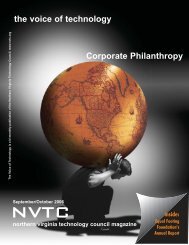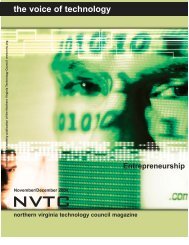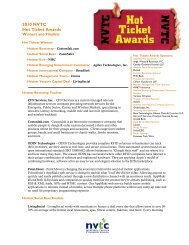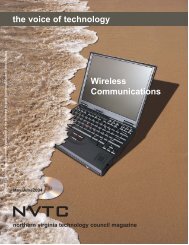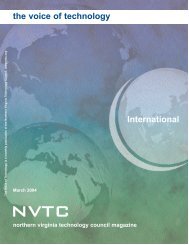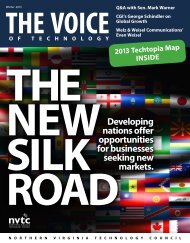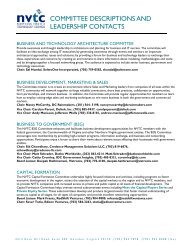Fall 2010 - Northern Virginia Technology Council
Fall 2010 - Northern Virginia Technology Council
Fall 2010 - Northern Virginia Technology Council
Create successful ePaper yourself
Turn your PDF publications into a flip-book with our unique Google optimized e-Paper software.
TelecoM Today: a New woRld of NeTwoRkiNg<br />
network connects more than 14,000 office buildings to some 300<br />
data centers across the country. The company also plans to quadruple<br />
the number of buildings it wires this year. Level 3 has also<br />
seen growth in fiber; the company touts the benefits of operating<br />
an all-IP network as a key to supporting its unified communications<br />
and managed services — and likens data transmission on<br />
legacy networks to a “car on a railroad track.”<br />
Cox became the first multiple system cable operator (MSO) to<br />
enter the business Ethernet market in 2007. Key benefits to consumers<br />
include flexibility and scalability, according to Myers. “Not<br />
all small businesses stay small businesses,” he says. With Metro<br />
Ethernet, “we can increase bandwidth in an hour.”<br />
Across its business offerings, Cox has focused on the small and<br />
medium-sized business market, now claiming more than 260,000<br />
business customers. While the majority takes advantage of phone<br />
and data services, Cox Business is now offering sophisticated bundled<br />
services formerly seen in the enterprise space to smaller businesses,<br />
including managed security, storage, backup and hosting.<br />
“Everybody is going into that segment because it’s been underserved<br />
and is still growing,” Myers says.<br />
Phone and cable companies have also made costly fiber investments<br />
in the consumer market to provide bundled services.<br />
Looking ahead, analysts speculate that these companies’ offerings<br />
could ultimately include such services as connected home security<br />
devices and thermostats that subscribers could control from their<br />
mobile phones.<br />
While fiber is powering so much of our telecommunications<br />
future, there’s another example of going back to the future in the<br />
Ethernet world. XO and others have developed ways to deliver<br />
Ethernet connectivity over the same twisted copper pairings developed<br />
by Alexander Graham Bell; the venerable technology can<br />
now transmit up to 20 Mbps. “It takes a legacy material and modernizes<br />
it,” says Topliesk.<br />
would alert the hospital if it detected a fall in a homebound patient.<br />
Security cameras, transponders that track cargo or trucking<br />
fleets around the world… the possibilities are endless, and companies<br />
are just beginning to explore them.<br />
Outside of San Francisco, Sprint opened an M2M collaboration<br />
center in late <strong>2010</strong> to provide a testbed for such emerging<br />
technologies; some 30 partners are now working at the center to<br />
develop new products for both business and consumer use. One<br />
experiment involves digital billboards, which would use wireless<br />
technology to display targeted advertising in places like shopping<br />
malls — and to tell marketers exactly how many people stop to<br />
look at it. AT&T has opened a similar certification center for what<br />
it calls “non-traditional, wirelessly enabled devices,” including the<br />
Interceptor Ignition Interlock, a court-ordered in-car breathalyzer<br />
that can now transmit data to law enforcement in real-time. The<br />
company says more than 300 M2M devices are now certified to<br />
operate on its network.<br />
According to Sprint, there will be 1 trillion — trillion with a<br />
“t” — Internet-connected devices by 2013. Of them, 412 million<br />
will be M2Mers. Let’s just hope that if the Internet refrigerator<br />
really comes to fruition, it doesn’t decide to start posting pictures<br />
of that moldy Tupperware container sitting in the back<br />
corner to Facebook.<br />
M2M:<br />
The Rise of the Machines<br />
Back in the heady early days of the Internet, there was a lot of<br />
breathless talk about plugging household appliances into the ‘Net<br />
as well as the wall — contraptions like wired refrigerators that<br />
would email the grocery store as soon as they sensed the milk was<br />
running low. While we’re still using pen-and-paper grocery lists,<br />
the machines are starting to talk amongst themselves.<br />
Called machine-to-machine, or M2M, the idea is to allow wireless<br />
devices to communicate with each other without human intervention.<br />
Consider a smart electric meter that sends real-time<br />
information about power consumption back to the utility, helping<br />
avoid brownouts. Or a glucose meter embedded with the same<br />
accelerometer that lets smartphone users play Angry Birds that<br />
The idea is to allow<br />
wireless devices to<br />
communicate with<br />
each other without<br />
human intervention.<br />
<strong>Fall</strong> 2011 www.nvtc.org THE VOICE OF TECHNOLOGY 19





